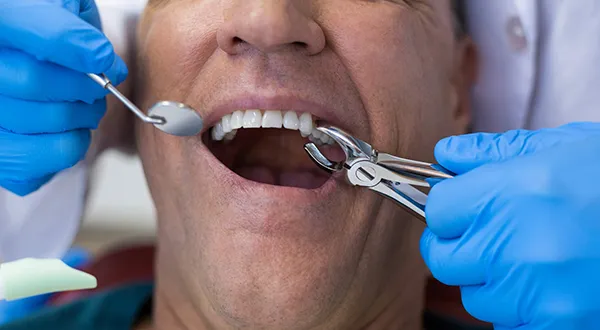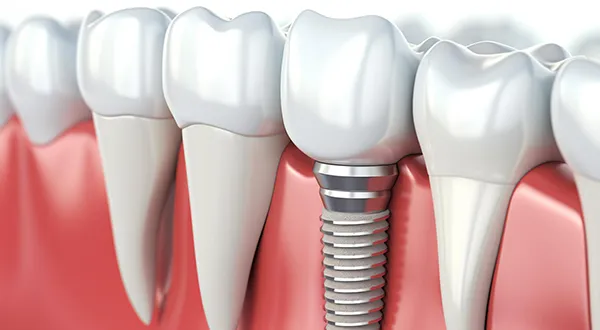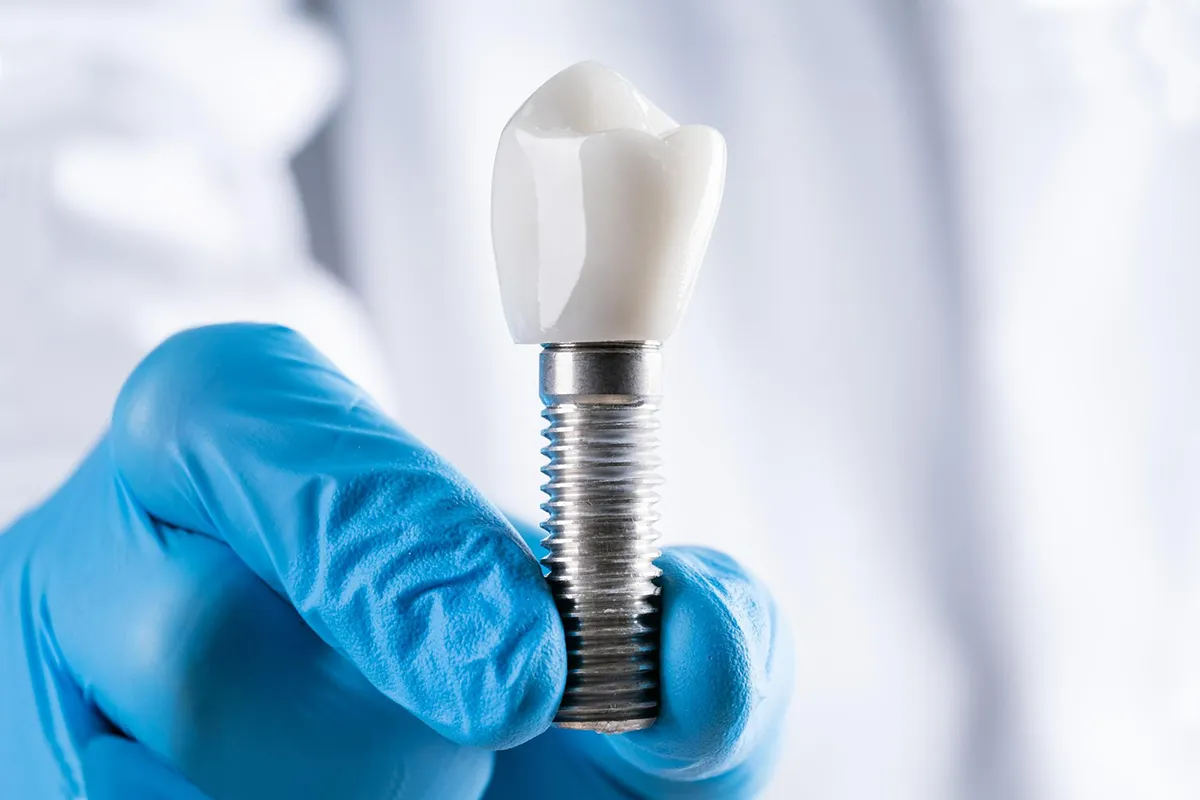Dental implant surgery is a specialized procedure crafted to replace missing teeth with artificial counterparts that mimic natural teeth. The dental implant (a small, biocompatible titanium post or frame)) is at the heart of this surgical intervention. This implant is strategically positioned into the jawbone beneath the gums, establishing a stable foundation for attaching artificial teeth.
The whole process happens in different steps, starting with checking the patient’s oral health and making a plan for the treatment. If necessary, the dentist may extract the existing teeth. The dentist may take additional measures to ensure the jawbone’s strength for the implants, such as bone grafting.
The essence of dental implant surgery lies in the precise surgical placement of implants into the jawbone, acting as artificial roots. After this, during the osseointegration period, the jawbone gradually merges with the implanted posts and establishes an enduring connection.
After successful osseointegration, dentists attach abutments to implants, serving as connectors for customized prosthetic teeth, often in crowns. This process produces a natural-looking and resilient solution for smile restoration.
Stages Involved in Dental Implant Surgery:
Dental implant surgery is a multi-stage process meticulously designed to restore smiles with lasting results. Here’s a description of the various stages of dental implant placement for your enlightenment.
Initial Assessment and Treatment Planning:
The first stage involves a comprehensive evaluation, diagnostic testing, and the creation of an individualized treatment plan. Dentists initiate this stage by thoroughly examining the patient’s oral cavity. It involves visually inspecting the teeth, gums, and surrounding tissues to identify existing issues or conditions. The dentist evaluates the overall condition of the oral cavity, checking for signs of decay, gum disease, or any abnormalities that might impact the implant procedure.
Diagnostic tools such as X-rays reveal the patient’s oral anatomy. X-rays provide a detailed view of the underlying bone structure, allowing dentists to assess its density and identify potential challenges or areas requiring special attention. Impressions, commonly made using molds or digital scanning technology, are also utilized to create detailed replicas of the patient’s teeth. They aid in further analysis and planning.
Tooth Extraction (if necessary):
The stage of tooth extraction comes into play when a natural tooth occupies the designated implant site. This phase begins with carefully evaluating whether the existing natural tooth needs extraction. Reasons for extraction may include severe decay, damage, or other conditions that hinder the success of the implant.

If extraction is deemed necessary, the dentist proceeds with precision. The goal is to remove the tooth efficiently, preserve the surrounding tissues, and minimize any disruption to the adjacent structures. Techniques such as gentle extraction and, in some cases, sectioning the tooth help ensure the most negligible impact on the surrounding gums and bone. Preservation of the surrounding tissues is a crucial focus during tooth extraction. Minimizing disruption to nearby structures is essential for maintaining the jawbone’s integrity and supporting the dental implant’s success. The tooth extraction stage is a preparatory step, creating space for the dental implant. By removing the existing tooth, the dentist makes room for placing the implant securely in the jawbone in the following steps.
Bone Grafting (if necessary):
When the patient exhibits insufficient bone density at the intended implant site, the dental implant journey may include a crucial step known as bone grafting. The decision to recommend bone grafting is rooted in a thorough assessment of the patient’s oral anatomy. Diagnostic tools, such as X-rays, help identify areas with inadequate bone density. This issue may arise due to factors like long-term tooth loss, periodontal disease, or natural variations in jawbone structure.
The dentist introduces additional bone material to the implant site during bone grafting. The dentist can source this material from various places, including the patient’s body, donor tissue, or synthetic alternatives. The graft is strategically placed in the deficient area to augment the bone structure. It then creates a more robust foundation for the subsequent implant placement.
“Dental implant placement prevents the deterioration of jawbone density and plays a crucial role in preserving facial structure.”
Implant Placement:
The essential aspect of dental implant surgery is the placement of the implant into the jawbone. The dentist initiates the procedure with surgical precision, making a small incision in the gum tissue at the predetermined implant site. This incision provides access to the underlying bone structure, marking the starting point for the implant placement. The dentist gains direct access to the jawbone with gently lifted gum tissue.
Careful drilling is then employed to create a precise and tailored space in the jawbone to accommodate the dental implant. The diameter and depth of this space are calculated with utmost precision, considering the specific dimensions of the chosen implant. The dental implant, typically a titanium post, is securely placed into the prepared space in the jawbone. Once the implant is securely in place, the incision in the gum is carefully closed.
The careful closure of the incision promotes proper healing and minimizes postoperative discomfort. The implant placement marks the initiation of the critical phase of osseointegration. Over the coming weeks and months, the implanted titanium post becomes biologically integrated with the natural bone. Ensuring patient comfort is a key focus during the implant placement process. Local anesthesia reduces procedure discomfort. Detailed postoperative care instructions provide a comfortable recovery.

Healing Period:
Following the precise dental implant placement, a crucial phase unfolds known as the healing period, during which osseointegration becomes the focus. Over the next few months, the implanted titanium post undergoes a remarkable process where it seamlessly fuses with the natural bone. Osseointegration occurs at a microscopic level, promoting the formation of new bone around and onto the implant.
The osseointegration process ensures the stability and longevity of the dental implant, enabling it to withstand the forces exerted during everyday activities like chewing. The biocompatibility of titanium facilitates osseointegration, making it an ideal material for dental implants. To ensure proper healing, patients must follow postoperative care instructions and attend regular dental check-ups to monitor osseointegration and address concerns.
Abutment Placement and Prosthetic Fabrication:
Following the successful completion of osseointegration, the dental implant process advances to the abutment placement. This crucial step involves attaching an abutment to the implanted titanium post. The abutment facilitates seamless integration between the implant and the prosthetic tooth.
Once the abutment is securely in place, the next stage starts, i.e., impressions and prosthetic fabrication. During this stage, the dental team meticulously records impressions of the abutment and the adjacent teeth. These impressions act as a detailed blueprint, guiding the dental laboratory in creating a personalized prosthetic tooth, commonly in the form of a crown. The precision of these impressions ensures that the prosthetic tooth aligns seamlessly with the patient’s natural dentition, both functionally and aesthetically.
Crown Placement and Follow-up Care:
The final step, i.e., crown placement, marks the culmination of the dental implant procedure. The carefully crafted prosthetic tooth is securely attached to the abutment, completing the restoration. This crowning achievement restores the patient’s smile and ensures optimal functionality.
Following the successful crown placement, the patient enters the follow-up care phase. Patients receive detailed postoperative care instructions during this period to facilitate proper healing.
Final Thoughts:
Dental implant surgery offers a durable solution for missing teeth. The procedure enhances oral function and aesthetic appeal, improving oral health and quality of life. It is a transformative option that requires careful consideration and planning. The implant surgery stages serve a specific purpose in the overall restoration process.
Contact your Pinole dentists, Dr. Azadeh Hosseini, DDS, and Dr. Ghazal Hosseini, DDS, at Top Pinole Dental to learn more about step-by-step Dental implant placement.
Resource:
Assessing Suitability for Dental Implants
*This media/content or any other on this website does not prescribe, recommend, or prevent any treatment or procedure. Therefore, we highly recommend that you get the advice of a qualified dentist or other medical practitioners regarding your specific dental condition.*
1500 Tara Hills Dr., Suite 104A, Pinole, CA 94564
Monday – Saturday 8:00 AM to 5:00 PM
